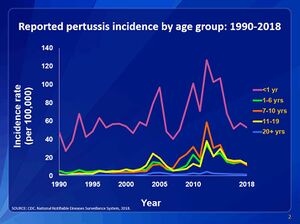Bordetella pertussis and the Importance of Vaccination
Introduction and History

By Alexandra White
At right is a sample image insertion. It works for any image uploaded anywhere to MicrobeWiki.
The insertion code consists of:
Double brackets: [[
Filename: download.jpg
Thumbnail status: |thumb|
Pixel size: |300px|
Placement on page: |right|
Legend/credit:
Closed double brackets: ]]
Other examples:
Bold
Italic
Subscript: H2O
Superscript: Fe3+
Sample citations: [1]
[2]
A citation code consists of a hyperlinked reference within "ref" begin and end codes.
To repeat the citation for other statements, the reference needs to have a names: "<ref name=aa>"
The repeated citation works like this, with a forward slash.[1]
Bordetella pertussis and Infection Stages
Include some current research, with at least one figure showing data.
Every point of information REQUIRES CITATION using the citation tool shown above.
Italic
B. pertussis is a gram-negative, aerobic coccobacillus bacteria a part of the genus Bordetella (Guiso 2009). Pertussis is a human-specific pathogen causing severe respiratory disease that cannot survive outside of its host (Guiso 2009). Infection occurs with B. pertussis entering through the host airway via respiratory droplets from an already infected individual, usually from coughing (smith et al 2001). B. pertussis then proceeds down the respiratory tract and adheres to ciliated epithelial cells in the trachea and nasopharynx (Smith et al 2001). Once the bacteria is attached it begins to replicate and colonies with-in the host cells (Smith et al 2001). Toxins are secreted by micro-organism which inflict damage to the epithelial lining, resulting in loss of ciliated cells which induces the coughing most commonly associated with whooping cough (Smith et al 2001). The pertussis toxins released also allow the bacteria to avoid host immune response by interfering with clearance mechanisms (Smith et al 2001). The damage caused by the toxins released by the replicating bacteria also halts ciliary function, short-circuiting host G proteins signaling apparatus, and also inhibits immune cell functions by up-regulating cAMP levels (Smith et al 2001).
The infection of B. pertussis has an incubation period of seven through ten days but a range of four through 21 days (Havers et al. 2021). Infection consist of three stages: catarrhal, paroxysmal, and convalescent (Havers et al. 2021). Catarrhal stage starts the onset of symptoms including runny nose, sneezing, and a minor cough (Havers et al. 2021). One to two weeks later the cough becomes more severe and the disease progresses into the paroxysmal stage (Havers et al. 2021). A fever is either not present or has minimal presence during infection at any stage (Havers et al. 2021). The paroxysmal stage is commonly when whooping cough is diagnosed due to numerous, rapid coughs due to thick mucus building up (Havers et al. 2021). The end of the paroxysmal stage begins with a high-pitched whoop and difficulty breathing where the infected individual may become cyanotic (blue or purple discoloration due to lack of oxygen) (Havers et al. 2021). These symptoms usually occur as attacks rather than continuous symptoms (Havers et al. 2021). They occur more often during the night and may reach 15 attacks in 24 hours (Havers et al. 2021). This stage may last anywhere from one week to 10 weeks (Havers et al. 2021). The convalescent stage consists of a gradual recovery yet paroxysmal symptoms may reoccur and cause respiratory infections for months after diagnosis (Havers et al. 2021).
B. Pertussis Vaccine History
Include some current research, with at least one figure showing data.
Italic
Vaccine Virulence
Include some current research, with at least one figure showing data.
Why Vaccination?

Conclusion
References
Authored for BIOL 238 Microbiology, taught by Joan Slonczewski, 2022, Kenyon College
